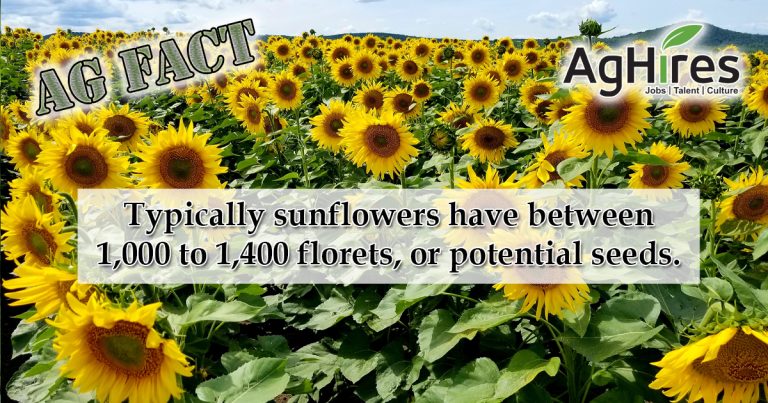
You may have seen the fields of sunflowers in full bloom in August or the at least the pictures on social media. These flowers are more than just a beautiful photo-op. Farmers grow sunflowers for their seeds to make sunflower seed oil and for consumption. Check out these 20 facts about sunflowers.
- Sunflowers are native to America. The flowers were cultivated in North America as early as 3000 BC, to be developed for food, medicine, dye, and oil.
- The flowers originated in the area known as the prairie states of the United States. They are also the state flower of Kansas.
- Spanish conquistadors exported the flowers to the rest of the world by around 1500.
- Tsar Peter the Great took some of the flowers back to Russia with him from the Netherlands where they became popular when it was discovered sunflower seed oil was not banned during Lent, unlike other oils the Russian Orthodox Church banned patrons from consuming. By the 19th century, about two million acres of sunflowers were planted in the country every year.
- Sunflower production in America exploded a few times in history. In the 19th century when Russian immigrants brought back seeds that grew bigger blooms. Again in 1946 when Missouri farmers began producing sunflower oil after Canada developed a seed-crushing machine. In the 1970s consumers took to sunflower seed oil as a low-cholesterol alternative to animal fats.
- Sunflowers need a lot of sun. The flowers grow best with about 6 to 8 hours of sun a day, but more is better.
- On average, they can grow as tall as 16 feet. The stem can grow as tall as 12 ft, while the head can reach over 12 inches in diameter. However, many varieties have been developed to flourish at different heights.
- If the flowers are planted too close together, they will compete and not blossom to their full potential.
- Sunflower buds and young blossoms will face east in the morning and follow the sun throughout the day. However, as they get heavier during seed production, the stems will stiffen, and the mature flower heads will usually remain facing east.
- Each sunflower’s head is made of smaller flowers.
- The petals around the outside are called ray florets, which cannot reproduce. On the other hand, the disc florets in the middle, where the seeds develop, have both male and female organs, and each produce a seed. They can self-pollinate or take pollen transported by insects or blown by the wind.
- Typically sunflowers have between 1,000 to 1,400 florets, and potential seeds.
- Once the flower heads are empty of seeds, they can be converting into disposable scrubbing pads for jobs too tough for your cleaning tool.
- Ukraine is the largest sunflower seed producer, followed by Russia.
- South Dakota is the largest producer of sunflowers in the United States, followed by North Dakota and Texas.
- There are two main types of sunflower seeds. Black seeds, also known as Black Oil, are 45% richer in Sunflower oil and are mainly used in manufacturing. Grey seeds, also known as White seeds, are mostly used for snacks and animal food, such as bird seed.
- The United States produces oil-type sunflowers and non-oil sunflower seeds.
- The growing season for sunflowers in the United States is from June to September.
- Oil-type seeds contain between 38% to 50% oil. So, for every 100 pounds of seeds, about 40 pounds of oil is produced.
- Non-oil seeds have a lower oil percentage and are divided into 3 categories. Food-grade, ingredient, and other. Food-grade seeds are usually the largest and cleanest. Ingredient sunflower seeds are still good quality, but do not have the right characteristics. The rest of the seeds are then used in bird seed and other animal feed because they are usually a smaller, low quality product.

Want more Agriculture Facts? Click here
Follow us on Facebook and Twitter to get your weekly dose of Ag Facts.
Search Floriculture Jobs here.
Search Horticulture Jobs here.
Sign Up for Our Email Newsletter and get ag facts bi-monthly, plus new jobs in agriculture.
Sources:
West Coast Seeds
Mental Floss
Beef2Live.com
University of Arizona College of Agriculture and Life Sciences
Statista
Agricultural Marketing Resource Center
Read these interesting sunflower facts to brighten your day!






